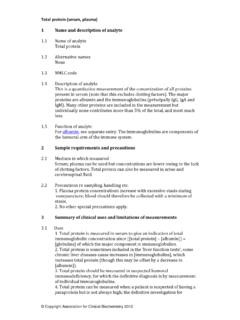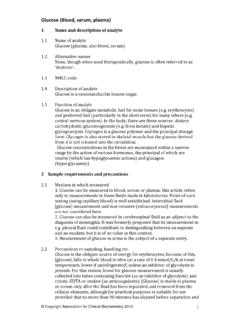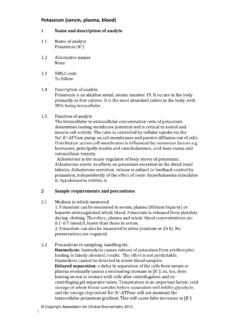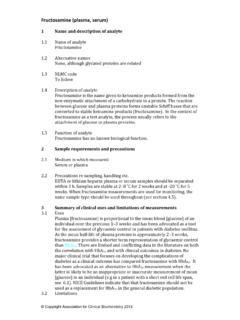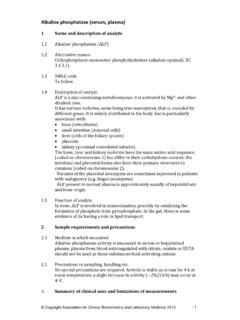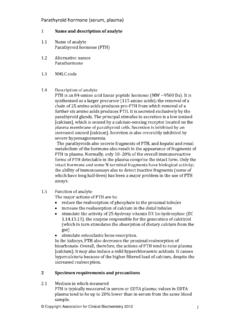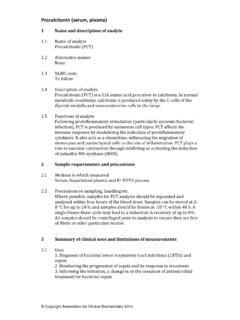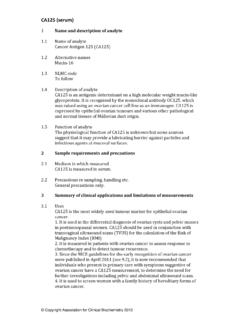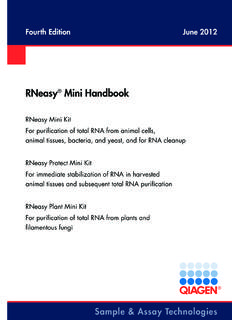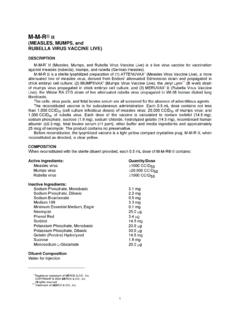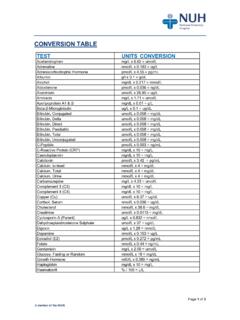Transcription of Calcium (serum, plasma, blood) - Association for Clinical ...
1 Copyright Association for Clinical Biochemistry 2012 1 Calcium ( serum , plasma , blood ) 1 Name and description of analyte Name of analyte Calcium (total in serum , plasma , ionised in blood (see (2)). Alternative names None NMLC code Description of analyte Calcium is an essential mineral. In the plasma , it is present in three forms: free ionised (Ca++) protein bound (principally to albumin) complexed (primarily with phosphate). Only the free ionised fraction (approximately 50% of the total) is physiologically active. This fraction is often referred to as ionised Calcium but this is incorrect, as protein bound Calcium is also ionised: the term free Calcium is to be preferred. plasma [free Calcium ] is closely regulated by the combined actions of parathyroid hormone and calcitriol (1,25 dihydroxyvitamin D). Changes in plasma [albumin] can alter total [ Calcium ] independently of free [ Calcium ].)
2 Most laboratories report a value for adjusted/corrected [ Calcium ] by adjusting the measured value for any abnormality of [albumin]. A frequently used formula is: adjusted [ Calcium ] = (measured [ Calcium ] + (40 [albumin])) but such formulae are unreliable with [albumin] <25 g/L, with abnormal concentrations of globulins (which also bind Calcium ), jaundice, high [free fatty acids] or abnormal blood [H+]. Function of analyte Calcium has numerous functions, including the control of ion transport across cell membranes (particularly relevant to excitable tissues), acting as an intracellular second messenger, activation of blood coagulation factors, coupling neuromuscular excitation and providing the strength and rigidity of bones and teeth. 2 Sample requirements and precautions Total Calcium is usually measured in serum or plasma (but NOT from blood anticoagulated with citrate, oxalate or ethylenediamine tetraacetic acid (EDTA).)
3 Calcium can also be measured in urine, particularly in the context of diagnosing familial hypocalciuric hypercalcaemia. 2. Free Calcium is ideally measured in heparinised whole blood (but)) but can be measured in serum or heparinised plasma . blood for measurement of total Calcium should ideally be drawn from a vein in which the blood is free flowing (that is, without a tourniquet) because venous stasis can result in loss of fluid across the wall of the vein and a relative increase in protein bound [ Calcium ]. In practice, 2 3 minutes of venous stasis has a negligible effect. Copyright Association for Clinical Biochemistry 2012 22. The distribution of Calcium between being protein bound or in free solution is dependent on [H+] (pH). Because this can change in vitro, measurements of free Calcium should be made rapidly after the blood has been drawn and ideally be peformed within 30 minutes (longer if the sample is kept at 4 oC.
4 In practice, this is usually not problematical, as free Calcium is measured primarily using point of care instruments. 3 Summary of Clinical uses and limitations of measurements Uses Calcium should be measured: when hypo or hypercalcaemia is suspected on Clinical grounds in conditions or circumstances known to cause hypo or hypercalcaemia ( renal disease and certain malignacies, respectively) in the management of patients with hypo or hypercalcaemia as part of the investigation of suspected metabolic bone disease (typically with phosphate concentration and alkaline phosphatase activity in a bone profile ). Measurements of free Calcium provided at point of care are particularly useful in patients undergoing parathyroid surgery and patients receiving blood or blood products in which anticoagulants may combine with Calcium ions and so cause a fall in their concentration. Calcium is frequently included in biochemical profiles.
5 The practice undoubtedly leads to further testing when slightly abnormal results are found that, on retesting, are found to be statistical outliers. However, primary hyperparathyroidism is frequently diagnosed as a result of such opportunistic measurement. Limitations The potential effect of an abnormal concentration of albumin on total [ Calcium ] should be considered and an adjusted value calculated and reported if this is not done automatically. Such calculations are invalid in severe acidosis and alkalosis, which disturb the binding of Calcium to albumin. Binding of Calcium to a paraprotein may also cause a high total Calcium concentration and is not allowed for by conventional correction formulae. 4 Analytical considerations Calcium can be measured using one of three techniques. 1. Compleximetric methods. These involve the formation of a coloured complex with either o cresolphthalein of arsenazo III.
6 In alkaline solution, combination of Calcium with the former results in the formation of a chromophore absorbing at 570 580 nm. Calcium and arsenazo III produce a complex in slightly acid solution that is measured at 650 nm. Some methods use alkaline conditions to give greater absorbance changes. 2. Atomic absorption spectrophotmetry. Although accurate and precise, this method is not suited to automation and is rarely used. 3. Indirect potentiometry using a Calcium selective electrode. This is the technique used in point of care instruments and in a limited number of laboratory analyzers. Copyright Association for Clinical Biochemistry 2012 3 Reference method This is based on atomic absorption spectrophotometry. Reference material SRM (Standard Reference Material) 909 (National Institute for Standards and Technology, Washington DC, USA). Interference The o cresolphthalein complex method is subject to interference by magnesium, but this can be minimised by the addition of 8 hydroxyquinolone to the reaction mixture, buffering the latter at pH 12 and measuring the absorbance at 580 nm.
7 The arsenazo III method is less susceptible to interference. Ion selective electrodes are highly selective for Calcium . Sources of error The o cresolphthalein method and electrode methods are temperature sensitive; protein deposits on electrode membranes cause positive interference. Regular cleaning and instrument maintenance is essential for the production of reliable results. 5 Reference intervals and variance Reference interval (adults): mmol/L (total, adjusted), mmol/L (ionized). Reference intervals (others): [ Calcium ] falls during the first 24 h after birth but rises to adult values by one week. Extent of variation Interindividual CV: % Intraindividual CV: Index of individuality: CV of method: Critical difference: 8% Sources of variation Total [ Calcium ] falls during pregnancy as a consequence of the fall in [albumin]. Free [ Calcium ] is increased in acidosis and decreased in alkalosis.
8 6 Clinical uses of measurement and interpretation of results Uses and interpretation 1. Suspected hypo and hypercalcaemia Hypocalcaemia causes increased neuromuscular excitability: [ Calcium ] should be measured in patients with paraesthesiae, muscle cramps and spasms etc. The features of hypercalcaemia (anorexia, abdominal pain, altered mentation, polyuria etc.) are less specific. If hypo or hypercalcaemia are identified, serial measurements are required for monitoring. Note that severe hypercalcaemia is a medical emergency. 2. Calcium should be measured in conditions known to cause hypocalcaemia (see ) or hypercalcaemia (see ). Copyright Association for Clinical Biochemistry 2012 43. Calcium should be measured in patients with suspected metabolic bone disease but is not usually abnormal in osteoporosis, in Paget s disease (except in immobilised patients) and may not be low in patients with osteomalacia or rickets.
9 [ Calcium ] is elevated in patients with hyperparathyroid bone disease, but many patients with hyperparathyroidism do not have Clinical or radiological evidence of bone disease. Confounding factors [ Calcium ] must always be interpreted in relation to [albumin] (see ). Hypomagnesaemia can both mimic and cause hypocalcaemia. 7. Causes and investigation of abnormal results Low values Causes In the majority of instances there is Clinical evidence of the cause of hypocalcaemia. More frequent causes include: vitamin D deficiency (privational and functional) renal failure pancreatitis hypomagnesaemia hypoparathyroidism. Investigation Mild hypocalcaemia (> mmol/L), particularly in an asymptomatic individual, should be confirmed by a repeat test to exclude the result s being a statistical outlier. If the cause of hypocalcaemia is not obvious from Clinical or other evidence, it should be investigated initially by measuring [creatinine], [magnesium], [PTH] and [25 OHvitamin D].
10 Except in hypoparathyroidism and hypomagnesaemia, [PTH] is usually increased in hypocalcaemia (secondary hyperparathyroidism). High values Causes There are numerous causes of hypercalcaemia. The most frequent are: hyperparathyroidism (the commonest cause in asymptomatic individuals); this may be a component of multiple endocrine neoplasia (MEN), particularly in younger patients malignancy (with or without osseous metastases; such patients often have Clinical evidence of the underlying disease, of which squamous cell carcinoma is the most frequent). Other causes include: idiopathic hypocalciuric hypercalcaemia treatment with thiazide diuretics treatment with lithium sarcoidosis thyrotoxicosis adrenal failure use of 1 hydroxylated derivatives of vitamin D in chronic kidney disease. Investigation Copyright Association for Clinical Biochemistry 2012 5 Mild hypercalcaemia (> mmol/L), particularly in an asymptomatic individual should be confirmed by a repeat measurement to exclude the result being a statistical outlier.
